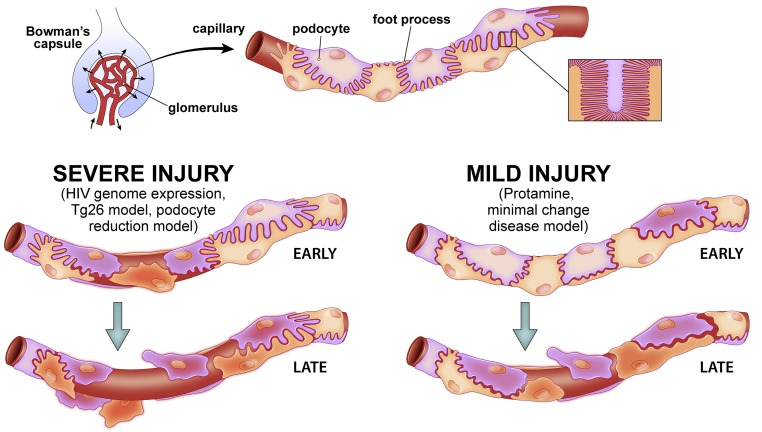Figure 9.
Representation of the effects of focal severe injury (e.g., HIV genome expression, Tg26 model, and podocyte reduction model) and mild diffuse injury (protamine and minimal change disease model) on podocyte behavior on glomerular capillary walls. Normal podocytes on a capillary (top center) have foot process interdigitations that provide full coverage of the GBM. In focal severe injury (left path), an injured podocyte, such as could occur with HIV infection or in a podocyte reduction model, becomes structurally disordered. Podocyte injury corresponds to increased deformability, reduced adhesion, and reduced ability to generate traction force. Thus, with sufficiently severe injury, the injured podocyte loses its connections to neighboring podocytes (early). Loss of contact and ability to generate traction force against the primarily injured cell, which ultimately detaches from the GBM (red) and is lost, induces changes in cytoskeletal structure and gene expression patterns in neighboring cells, propagating a cycle of secondary cell injury due to abnormal mechanical environment. This cycle of injury can result in progressive podocyte loss from glomerular capillaries (late). In diffuse, mild injury (right path), which could occur with repeated puromycin aminonucleoside administration or minimal change disease, the injured cells are better preserved than the severely injured red cell in the left path. However, injured cells have increased deformability, adhere less well to the matrix and each other, and have reduced ability to generate traction force. With exposure to shear and distending forces, some podocytes detach from capillary walls, leading to a progressive process similar to that described above but slower than the severe injury scenario. In both severe and mild injury, if enough podocytes are affected and lost, the resultant abnormal biophysical environment could be sufficient to promote progressive loss of glomerular function. Rapid loss of podocytes in the absence of a fibrotic response could result in short-term capillary failure, whereas the basic structure would be preserved in a state that progressed more slowly and allowed fibrosis to develop.

